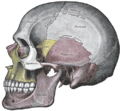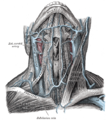- Human mandible
-
- This article is about the human jawbone. For the other mandibles, see Mandible.
Bone: Mandible Mandible. Outer surface. Side view Mandible. Inner surface. Side view Latin mandibula Gray's subject #44 172 Precursor 1st branchial arch[1] MeSH Mandible The mandible [pronunciation] (from Latin mandibula, "jawbone") or inferior maxillary bone forms the lower jaw and holds the lower teeth in place. The term "mandible" also refers to both the upper and lower sections of the beaks of birds; in this case the "lower mandible" corresponds to the mandible of humans, while the "upper mandible" is functionally equivalent to the human maxilla but mainly consists of the premaxillary bones. Conversely, in bony fish for example, the lower jaw may be termed "lower maxilla".
Contents
Components
The mandible consists of:
- a curved, horizontal portion, the body. (See body of mandible).
- two perpendicular portions, the rami, which unite with the ends of the body nearly at right angles. (See ramus mandibulae)
- Alveolar process, the tooth bearing area of the mandible (upper part of the body of the mandible)
- Condyle, superior (upper) and posterior projection from the ramus, which makes the temporomandibular joint with the temporal bone
- Coronoid process, superior and anterior projection from the ramus. This provides attachment to the temporalis muscle
Foramina (singular = foramen)
- Mandibular foramen, paired, in the inner (medial) aspect of the mandible, superior to the mandibular angle in the middle of the ramus.
- Mental foramen, paired, lateral to the mental protuberance on the body of mandible.
Nerves
A panoramic radiographic reveals the mandible, including the heads and necks of the mandibular condyles, the coronoid processes of the mandible, as well as the nasal antrum and the maxillary sinuses.
Inferior alveolar nerve, branch of the mandibular division of Trigeminal (V) nerve, enters the mandibular foramen and runs forward in the mandibular canal, supplying sensation to the teeth. At the mental foramen the nerve divides into two terminal branches: incisive and mental nerves. The incisive nerve runs forward in the mandible and supplies the anterior teeth. The mental nerve exits the mental foramen and supplies sensation to the lower lip.
Articulations
The mandible articulates with the two temporal bones at the temporomandibular joints.
Pathologies
One fifth of facial injuries involve mandibular fracture.[2] Mandibular fractures are often accompanied by a 'twin fracture' on the contralateral (opposite) side.
Etiology
- Motor vehicle accident (MVA) – 40%
- Assault – 40%
- Fall – 10%
- Sport – 5%
- Other – 5%
Location
- Condyle – 30%
- Angle – 25%
- Body – 25%
- Symphesis – 15%
- Ramus – 3%
- Coronoid process – 2%
The mandible may be dislocated anteriorly (to the front) and inferiorly (downwards) but very rarely posteriorly (backwards).
Additional images
See also
- Bone terminology
- Terms for anatomical location
- Changes produced in the mandible by age
- Ossification of the mandible
- Oral and maxillofacial surgery
- Simian shelf
References
- ^ hednk-023 — Embryology at UNC
- ^ Levin L, Zadik Y, Peleg K, Bigman G, Givon A, Lin S (August 2008). "Incidence and severity of maxillofacial injuries during the Second Lebanon War among Israeli soldiers and civilians". J Oral Maxillofac Surg 66 (8): 1630–3. doi:10.1016/j.joms.2007.11.028. PMID 18634951. http://www.sciencedirect.com/science?_ob=ArticleURL&_udi=B6WKF-4T0F864-K&_user=10&_rdoc=1&_fmt=&_orig=search&_sort=d&view=c&_version=1&_urlVersion=0&_userid=10&md5=e05fa24fcd1ba3f710eea659d919b6eb. Retrieved 2008-07-16.
External links
- SUNY Labs 34:st-0203 – "Oral Cavity: Bones"
- Diagram at uni-mainz.de
This article was originally based on an entry from a public domain edition of Gray's Anatomy. As such, some of the information contained within it may be outdated.
Bones of head and neck: the facial skeleton of the skull (TA A02.1.08–15, GA 2.156–177) Maxilla SurfacesProcessesOtherZygomatic Palatine FossaePlatesProcessesMandible external surface (Symphysis menti, Lingual foramen, Mental protuberance, Mental foramen, Mandibular incisive canal) · internal surface (Mental spine, Mylohyoid line, Sublingual fovea, Submandibular fovea) · Alveolar part of mandibleMinor/
noseNasal bone: Internasal suture · Nasal foramina
Inferior nasal concha: Ethmoidal process · Maxillary process
Vomer: Vomer anterior · Synostosis vomerina · Vomer posterior (Wing)
Lacrimal: Posterior lacrimal crest · Lacrimal groove · Lacrimal hamulusCategories:- Bones of the head and neck
Wikimedia Foundation. 2010.













